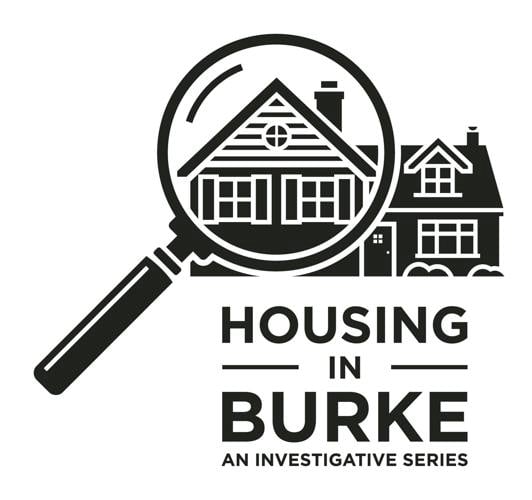

Two years into a project to turn an old junior high school in downtown Morganton into a 41-unit apartment complex, developer Dante Broadway isn’t sure he’d do it all over again.
After all, he bought the building when interest rates were much lower and before inflation drove up the cost of some building materials to virtually unprecedented levels.
“I don’t know that I would do it, knowing what I know now and how interest rates went up,” Broadway said with a slight grin. “Once you pull the trigger, man, you can’t stop. So, here we are.”
Broadway remains optimistic about the future of the project he and son-in-law Matt Conley are working on, but his dilemma is one encountered often by builders in the county. Rising construction costs make it harder than ever to reap a lucrative profit from developments, so building has slowed.
Couple that with the stratospheric rise in the costs of both rental and for-sale housing, and it’s easy to see why Burke County, like many others, is on the cusp of a potentially devastating housing shortage.
Based on projected population growth, Burke County is 5,000 houses short of where it should be, and the gap is expanding all the time, according to a housing needs assessment commissioned by the county and released earlier this year.
Most of the residential growth the area has seen lately has come in the form of scattered 50- to 60-unit apartment buildings, many of them subsidized housing, and a handful of subdivisions with space for five to 10 homes.
Incremental increases like those won’t make much of a dent in the deficit.
It’s going to take much larger neighborhoods filled with single family housing, more and bigger apartment complexes, and far more speculative (spec) houses — homes built by a developer before a buyer has been identified.
And those kinds of projects are few and far between.
“There are individuals building houses here but most of them are commissioned houses,” said Wendy Cato, Morganton’s Mayor Pro Tem and a longtime local realtor. “Not very many people are building specs, so until we get somebody who is willing to build 100, 150 houses in a development, I don’t think we can solve the problem anytime soon.
“Tract houses are really what we need, and we stopped building them during the Recession (2007-09). You can’t make up for 17 years of no building in two or three years.”
Land developer Steve Leadbetter agrees with Cato’s assessment.
“Spec builders have got to go out and build houses, because we’re in trouble,” said Leadbetter, whose Cottonwood Development office is headquartered near Lake James. “We have such a huge housing shortage.”
COST PROHIBITIVE?
A number of factors have combined to make it particularly difficult to build right now. Chief among them is the cost of materials.
For instance, in April 2009, lumber was $159.10 per thousand board feet in the U.S. By April 2012, it had risen nearly 10 times that to $1,372. 50. The price has since stabilized, but still stands at $438.50 as of last week.
“Price increases in materials make it difficult to budget and keep a targeted price point stable,” said Michael Brown of Tru West LLC, which is building townhomes on Fletcher Street in Morganton. “Several examples include concrete, insulation, and changes in HVAC regulations and costs.
“Mechanical subcontractors are becoming more and more scarce, and their time is limited, particularly when they cannot keep or hire new help. Labor costs are up because of less available labor and more demand.”
The county’s housing needs assessment found 80% of builders and developers surveyed said two of the biggest obstacles they faced were financing and the costs of labor and materials.
In addition to higher construction costs and rising interest rates, available land with costly infrastructure — water, sewer, and electricity — already in place is in short supply.
“I’ve got builders asking all the time if I have any lots, any land, and they’re ready to roll with several projects,” said real estate agent Whitney Willey of Remax Living. “Finding builders is not the problem. It’s finding the land.”
Local governments are trying to help, but their resources are limited.
The City of Morganton is expanding its water and sewer coverage, and the county is studying the feasibility of doing the same (see related story). Morganton offers grants to help with infrastructure costs and they’ve had modest results. Both entities plan to revisit some of their zoning codes.
Several developments have sprung up recently in Valdese, in part because infrastructure was already available on prospective sites.
Most of those are subsidized, however, and for builders hoping to put up market-rate housing, it’s an uphill struggle.
Alan Wood, President and CEO of Burke Development Inc., the county’s industrial recruitment arm, said other markets closer to Charlotte are experiencing housing growth spurts due to their proximity to the Queen City. As a result, builders are dubious about sinking their money into relatively unproven markets like Burke.
“Why would developers leave a market where they can build as fast as they can build and sell everything, and come into a market that’s not proven, sink their money in and take a chance?” Wood asked.
Wood added that’s an especially tough question when you factor in the time it takes to complete a project.
“If we had sites developed, I think we could turn that around,” Wood said. “But if you have a developer come in and start to develop a site, you’ve got to have acreage with the infrastructure in place to start. If the site is there and they started today, by the time you go through permitting and get everything, you’re looking at 18 to 24 months to get a subdivision ready to go, and that’s if everything goes right.”
IF YOU BUILD IT …
But there are those willing to give it a try.
Take Tru West, for instance.
The corporation is building a 27-unit complex called Beacon Townhomes inside the Morganton city limits on Fletcher Street, off Burkemont Avenue. Seven of the units will be finished this summer. The three-bedroom, two-bath, 1,600-square-foot homes will feature amenities like custom cabinets and granite countertops.
Brown said opportunities like the Fletcher Street project are becoming rarer all the time, so it’s important to take advantage of them now.
“Developable land opportunities are going to become scarcer, so we will have to find ways to maximize the opportunities that we have,” Brown said.
PRO-SPEC-TIVE BUYERS
Leadbetter is maximizing his opportunities with a foray into speculative housing.
He hopes to start with one home in the Silver Creek community. When it sells, he plans to construct two more. Ideally, he said, he’ll double the number each time.
Cottonwood specializes in high-quality builds in the mid to upper price ranges, and Leadbetter is excited about using some of the same techniques he employs on high–dollar homes to produce a more affordable product.
“I’ve always had a vision of building spec houses, so I can do what I want to do,” Leadbetter said. “We’re getting ready to start our first spec house. Our goal is to build a Cottonwood home — same level of quality as our multi-million-dollar houses — but try to design the house so it’s an affordable build. It will be something people will be proud of, and it won’t look just like everybody else’s home, and it will be a quality home.”
With prices around $600,000, Cottonwoods’ spec houses won’t be inexpensive. But as Leadbetter explained, homes may never be cheap again.
“The problem is, a 1,500-square-foot house, that is vinyl everything, vinyl windows, linoleum, fiberglass insert tubs, those are now $350,000 or $400,000,” Leadbetter said. “And your first-time, starter people, they can’t afford that. But that’s where we are now.”
UNICORN PROPERTY
Another developer, Carriage Park LLC, is working on a subdivision on Shore Drive that will accommodate up to seven houses on three- to four-acre lots. The city’s stimulus program will offset some of the costs for infrastructure.
But the builder, Brad Norvell, doesn’t expect the venture to be a lucrative one. He said the land has been in his family for half a century and he wanted a place to build a home for himself.
“I won’t make any money off of this,” Norvell said. “I hope I can sell the lots and pay for all the infrastructure. I probably wouldn’t do it if I didn’t want to put a house on it.
“We’ve owned it for 50 years, and I was looking for somewhere to build for myself. It’s a great location. You feel like you’re in the country but you’re minutes from downtown.”
Sites like that have long since become the exception rather than the rule.
THE WAY FORWARD
Despite the fact fewer large projects are being built — “There hasn’t been a major subdivision platted in over 20 years,” Wood remarked — developers are finding ways to move forward.
For Leadbetter, that means doing far more renovations than new builds. He said remodeling jobs are occupying more and more of his time.
“We’re really busy with renovations. That’s the future. We’re positioning ourselves to do a lot of remodels,” said Leadbetter. “Between new construction and remodels, we’ve got about 18 projects going on right now, which is a lot.”
“All our guys are as busy as can be.”
Cato said more developers are pulling groups of investors together instead of looking to banks for financing. She added property owners are giving developers land and then recouping their investments when the homes sell.
“Everybody is having to be very creative in how they’re funding things,” Cato said.
In fact, creativity might be the only way to remedy the situation.
“Grant programs are definitely helpful, and each individual property/project might present different opportunities to achieve the goal of developing the property, but there must be flexibility, as there is no one size fits all to real estate development,” Brown said. “Any efforts towards minimizing the time required to determine if a project is viable, as well as minimizing the time it takes to get the project off the ground would be very helpful, and we would see more ideas come to fruition.”






























(0) comments
Welcome to the discussion.
Log In
Keep it Clean. Please avoid obscene, vulgar, lewd, racist or sexually-oriented language.
PLEASE TURN OFF YOUR CAPS LOCK.
Don't Threaten. Threats of harming another person will not be tolerated.
Be Truthful. Don't knowingly lie about anyone or anything.
Be Nice. No racism, sexism or any sort of -ism that is degrading to another person.
Be Proactive. Use the 'Report' link on each comment to let us know of abusive posts.
Share with Us. We'd love to hear eyewitness accounts, the history behind an article.